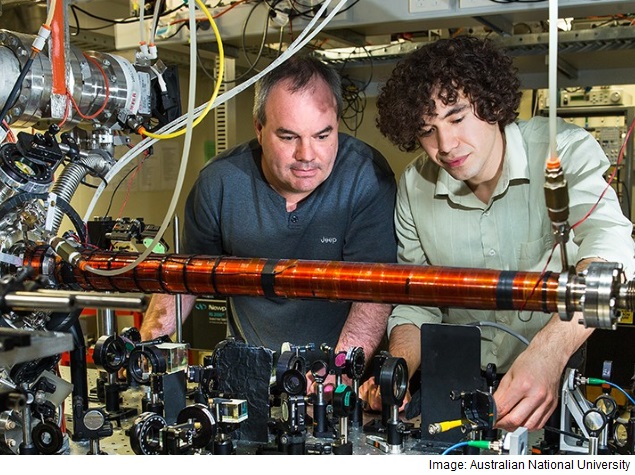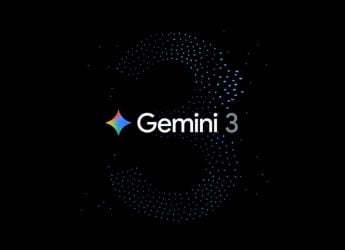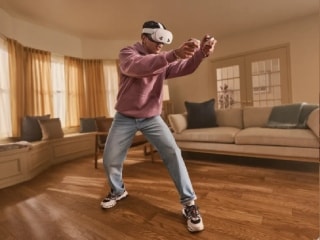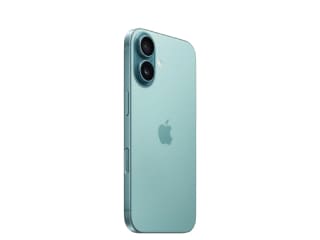- Home
- Science
- Science News
- Quantum Experiment Confirms Reality Doesn't Exist Until Measured
Quantum Experiment Confirms Reality Doesn't Exist Until Measured

Physicists at The Australian National University (ANU) have conducted John Wheeler's delayed-choice thought experiment, which involves a moving object that is given the choice to act like a particle or a wave.
Wheeler's experiment then asks - at which point does the object decide?
Common sense says the object is either wave-like or particle-like, independent of how we measure it. But quantum physics predicts that whether you observe wave like behaviour (interference) or particle behaviour (no interference) depends only on how it is actually measured at the end of its journey.
This is what the ANU team found in its experiment.
"It proves that measurement is everything. At the quantum level, reality does not exist if you are not looking at it," said Associate Professor Andrew Truscott from the ANU Research School of Physics and Engineering.
The results confirm the validity of quantum theory, which governs the world of the very small, and has enabled the development of many technologies such as LEDs, lasers and computer chips, researchers said.
The ANU team succeeded in building the experiment, which seemed nearly impossible when it was proposed in 1978, and reversed Wheeler's original concept of light beams being bounced by mirrors, and instead used atoms scattered by laser light.
Truscott's team first trapped a collection of helium atoms in a suspended state known as a Bose-Einstein condensate, and then ejected them until there was only a single atom left.
The single atom was then dropped through a pair of counter-propagating laser beams, which formed a grating pattern that acted as crossroads in the same way a solid grating would scatter light.
A second light grating to recombine the paths was randomly added, which led to constructive or destructive interference as if the atom had travelled both paths.
When the second light grating was not added, no interference was observed as if the atom chose only one path.
However, the random number determining whether the grating was added was only generated after the atom had passed through the crossroads.
If one chooses to believe that the atom really did take a particular path or paths then one has to accept that a future measurement is affecting the atom's past, said Truscott.
"The atoms did not travel from A to B. It was only when they were measured at the end of the journey that their wave-like or particle-like behaviour was brought into existence," he said.
The research is published in the journal Nature Physics.
Get your daily dose of tech news, reviews, and insights, in under 80 characters on Gadgets 360 Turbo. Connect with fellow tech lovers on our Forum. Follow us on X, Facebook, WhatsApp, Threads and Google News for instant updates. Catch all the action on our YouTube channel.
Related Stories
- Samsung Galaxy Unpacked 2025
- ChatGPT
- Redmi Note 14 Pro+
- iPhone 16
- Apple Vision Pro
- Oneplus 12
- OnePlus Nord CE 3 Lite 5G
- iPhone 13
- Xiaomi 14 Pro
- Oppo Find N3
- Tecno Spark Go (2023)
- Realme V30
- Best Phones Under 25000
- Samsung Galaxy S24 Series
- Cryptocurrency
- iQoo 12
- Samsung Galaxy S24 Ultra
- Giottus
- Samsung Galaxy Z Flip 5
- Apple 'Scary Fast'
- Housefull 5
- GoPro Hero 12 Black Review
- Invincible Season 2
- JioGlass
- HD Ready TV
- Laptop Under 50000
- Smartwatch Under 10000
- Latest Mobile Phones
- Compare Phones
- Realme P4x 5G
- OnePlus Ace 6T
- Nubia Flip 3
- Nubia Fold
- OPPO A6x 5G
- Samsung Galaxy Z TriFold
- Poco F8 Ultra
- Poco F8 Pro
- Asus ProArt P16
- MacBook Pro 14-inch (M5, 2025)
- Poco Pad M1
- Poco Pad X1
- Just Corseca Skywatch Pro
- Honor Watch X5
- Acerpure Nitro Z Series 100-inch QLED TV
- Samsung 43 Inch LED Ultra HD (4K) Smart TV (UA43UE81AFULXL)
- Asus ROG Ally
- Nintendo Switch Lite
- Haier 1.6 Ton 5 Star Inverter Split AC (HSU19G-MZAID5BN-INV)
- Haier 1.6 Ton 5 Star Inverter Split AC (HSU19G-MZAIM5BN-INV)
-
 Starlink Subscription Price in India Revealed as Elon Musk-Led Firm Prepares for Imminent Launch
Starlink Subscription Price in India Revealed as Elon Musk-Led Firm Prepares for Imminent Launch
-
 Google Releases Gemini 3 Deep Think Model to Its Most Expensive Subscription Tier
Google Releases Gemini 3 Deep Think Model to Its Most Expensive Subscription Tier
-
 Meta’s Phoenix Mixed Reality Smart Glasses Reportedly Delayed; Could Finally Launch in 2027
Meta’s Phoenix Mixed Reality Smart Glasses Reportedly Delayed; Could Finally Launch in 2027
-
 iPhone 16 Deal Alert: Get It for Just Rs 65,900 Effective Price
iPhone 16 Deal Alert: Get It for Just Rs 65,900 Effective Price












